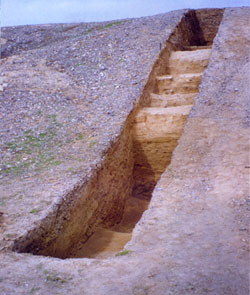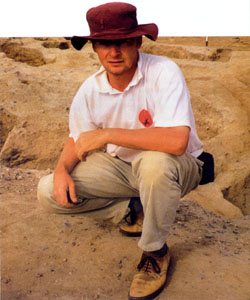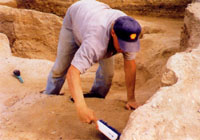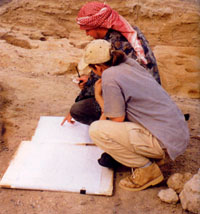 A team of British archaeologists excavating a major site in Ras Al Khaimah are more excited by ancient rubbish tips than finding gold coins.
A team of British archaeologists excavating a major site in Ras Al Khaimah are more excited by ancient rubbish tips than finding gold coins.
Behind a tall security fence in a farming area of Ras Al Khaimah, not
far from the tall mountains of the Al Hajjar range and the blue waters
of the Arabian Gulf, a group of scientists and labourers are busy at one
of the most important building sites in the United Arab Emirates.
Instead of pouring more concrete for another skyscraper, the team is on
its knees whittling down a massive dirt mound in order to reconstruct
vital missing elements in the history of this region and its peoples.
The ‘Shimal Tell’ excavation launched its third season in November at
the area which is known as Kush by the local inhabitants. A ‘tell’ is a
large mound which has been built up by the accumulation of many
centuries of human habitation on one site. According to Derek Kennet,
project leader and archaeologist who divides his time between Oxford
University and Ras Al Khaimah, the word is actually of Arabic origin and
has entered the archaeologist’s lexicon because so much early
architecture in this region was of mud brick. This building material
naturally erodes more rapidly than stone and has to be replaced
periodically, a process which creates sedimentation layers at the site
of habitation.
“The Shimal Tell is certainly one of the largest in this region,” said
Derek during a break from excavating. “Under the auspices of the
archaeology programme of the National Museum of Ras Al Khaimah, we
located this tell and selected it for a very ambitious excavation
project because of its potential to shed light on some phases of history
which are provoking much debate internationally among historians and
archaeologists.”
 While the professional diggers gingerly probed and brushed at the
exposed dirt surfaces of the 20 square metre excavation, Derek explained
the historical significance of the project. Because of the tell height,
the age of the site was estimated as between 1,000 and 2,000 years. One
of the fascinating historical issues which is encompassed by a site such
as this, therefore, is the change brought about by the rapid expansion
of Islam, which was a noteworthy historical accomplishment. “Their
military technology was not that sophisticated, and the tribes didn’t
have a great population to reinforce them. And yet they rapidly
conquered half of the two greatest empires of the time, the Roman and
the Iranian. Quite an amazing accomplishment.
While the professional diggers gingerly probed and brushed at the
exposed dirt surfaces of the 20 square metre excavation, Derek explained
the historical significance of the project. Because of the tell height,
the age of the site was estimated as between 1,000 and 2,000 years. One
of the fascinating historical issues which is encompassed by a site such
as this, therefore, is the change brought about by the rapid expansion
of Islam, which was a noteworthy historical accomplishment. “Their
military technology was not that sophisticated, and the tribes didn’t
have a great population to reinforce them. And yet they rapidly
conquered half of the two greatest empires of the time, the Roman and
the Iranian. Quite an amazing accomplishment.
“There are questions as to what was the environment of that achievement.
What were the economic and social changes before and after the
expansion? How did Islam change people’s lives in a practical way? How
were trading patterns altered? Actually, at the period we are talking
about, the 7th century, the Middle East was one of the most important
parts of the world in terms of historical developments.”
Many large Western universities such as Oxford have departments of
Islamic studies, with their historians engaged in the debate about the
process which occurred before, during and after the advent of Islam.
There is actually very little evidence to go on from the period. Not
much was written historically until about two centuries later, in the
Abassid dynasty, when concepts of the early Islamic period had already
been established. There is very little preserved from the period itself
which was written by Muslims. There are contemporary sources written by
Christians, but they tend to be biased.
“We haven’t got any fixed ideas,” Derek explained. “ We come here with
an open mind. We want to look at Kush as an example of an urban site in
the Arabian Peninsula which is founded before Islam and which survived
through to the next historical epoch.
“We want to look at the material from the site and try to understand
what it tells us about developments during that period. We’re trying to
reconstruct the economic and social changes on the site. We will use the
information gleaned from this site to contribute as archaeologists to
the debate.”
The evidence already unearthed at the Shimal Tell indicates a major
trading centre, originally sited on a khor. That body of water was deep
enough to accept sea-going vessels, so the scientists think it likely
that they have located the original site of the port of Julfar, which
has several references by early geographers.
The earliest Islamic source is Al Maktasi who was a Palestinian
historian and geographer writing in the 10th century. He attempted to
document the various parts of the Islamic world, and mentions Julfar as
being one of the towns of Oman, during the time when one of the earlier
dynasties of Oman controlled this region. Later Al Idrisi, an Arab
geographer working at the Norman court of King Roger in 12th century
Sicily, described Julfar as being a prosperous town next to the sea in
this portion of the Gulf.
 When the khor had silted up and the coastline shifted in approximately
the 14th century AD, the inhabitants moved to another site on the
present coast. The first European fleets arrived in 1501 with the
invasion of the Portuguese. The port had already shifted to its second
location by that time, so the Christian references to Julfar actually
refer to the second port, and the inland site being excavated would have already been abandoned.
When the khor had silted up and the coastline shifted in approximately
the 14th century AD, the inhabitants moved to another site on the
present coast. The first European fleets arrived in 1501 with the
invasion of the Portuguese. The port had already shifted to its second
location by that time, so the Christian references to Julfar actually
refer to the second port, and the inland site being excavated would have already been abandoned.
The excavation team includes four professional archeological diggers, a
paleobotanist, a flotation expert and a finds cataloguer, in addition to
the eight workmen. There are 12 specialists employed for the annual dig
of about six weeks duration, and with the specialised equipment such as
a powerful laboratory microscope, the project is an expensive
proposition.
The costs are being covered by a number of sponsors. The two largest
supporters have been the government of Ras Al Khaimah and Shell. The
Deputy Ruler of the emirate is Sheikh Sultan bin Saqr Al Qasimi, who
also happens to be Director of the RAK National Heritage Museum. Sheikh
Sultan is enthusiastic about archaeology, which is fortunate for
archaeology in the Gulf region, as Ras Al Khaimah holds more sites of
potential interest than most other areas.
Shell has generously provided much of the subsidy necessary to hire
professionals, develop the team, buy equipment and pay for processing
such as radiocarbon dating. The project has also been supported by the
National Bank of Ras Al Khaimah and the British Museum.
Five seasons of digging had originally been planned, with the current
effort being the third. Because of the complexity and strength of the
findings, the project leaders are considering extending the dig for an
additional season beyond what was originally scheduled. “We might have
underestimated the amount of time necessary,” says Derek with a shrug as
he examines the beehive of activity inside of the excavation. “We’re
well down into the site now, but there is much more than we anticipated.
In addition, after the digging has been finished, we’ll probably need a
season devoted to study, where we bring people out to shift through the
documented evidence that has been turned up and to integrate their
respective specialised findings into a comprehensive project report for
publication.”
The research design at Shimal is to elucidate an economic and
environmental sequence in the tell remains. The teams wants to determine
what people ate, grew, and traded, and how that changed through time.
Shahina Farid is the Field Director on the site, and she is an example
of the level of professional recruited for the project. She’s at work
about six months of the year at different sites throughout the Middle
East, and when she is back at her home base in London, she works with
what is called rescue archaeology. When modern construction exposes
accidentally a historical site, archaeologists are called in to as
rapidly as possible to excavate what remains, thus the element of
rescue.
Shahina explained the advanced technique being employed at Shimal. “Some
excavations in the Middle East are still employing a horizontal pit
technique which simply slices through a site relatively rapidly but
which fails to develop its complexity. For the Julfar dig we are
utilising the most scientifically advanced technique, called
stratigraphic archaeology. The concept was developed in the 50s to take
into account the complicated nature of such a concentrated site. A wide
trench is excavated slowly, enabling the mixtures of different age
strata to be exposed carefully and to put the finds such as pottery
shards into proper context. If you don’t dig properly, you simply don’t
get the full picture.”
The painstaking labour has already produced some surprises. A fortress
wall has been found, two and a half meters thick. The surrounding strata
contents indicate that it may have been a pre-Islamic fort of the
Sassanians, an Iranian dynasty which ruled Iran from about 230 AD to the
time of the Islamic conquest. They were the powerful equivalent in the
East of the late Roman Empire. Historically it is known that they had
colonies on the coast of Arabia, trading colonies which were probably
sited to dominate adjacent agricultural areas as well as the trade
routes of the time.
 Derek allowed himself a moment of historical hypothesis. “From what we
know of the period, it was the Arab tribes who lived in the hinterland
that became Moslems first, and they came to the coast and threw the
Sassanians out, who were practising Zoroastrians, fire worshippers. This
scenario is one possible interpretation of what we are looking at here
at this site.”
Derek allowed himself a moment of historical hypothesis. “From what we
know of the period, it was the Arab tribes who lived in the hinterland
that became Moslems first, and they came to the coast and threw the
Sassanians out, who were practising Zoroastrians, fire worshippers. This
scenario is one possible interpretation of what we are looking at here
at this site.”
A major find was located during the excavation of last year in one of
the several rubbish tips located on the site. A carbonised coffee bean
was found amongst the other organic materials sorted out in the
flotation tank. It was radiocarbon dated as being 12th century, which
made it the oldest coffee bean ever located. “Historians had come to the
conclusion that coffee didn’t start to circulate in the Arab world until
the 14th century,” said Adrian Parker, the team paleobotanist, as he
hunched over a microscope examining a tiny seed more than 600 years old
which was used as a powerful laxative. “The Ras Al Khaimah coffee find
pushed back the date of coffee consumption by 250 years, and confirmed
trade contacts with Yemen.”
An Omani gold coin from the 10th century was located during this
season’s dig, but the team members talked with much more excitement
about their favourite rubbish tips located during the excavation. Public
attention always focuses on the spectacular finds of artifacts or tombs
full of gold, but the archaeologist values just as much, if not more,
the small items such as the coffee bean which reveal the historical
processes which shaped the people’s lives on the site. Archaeologists
claim to be happier to dig a rubbish pit than to dig a treasure store.
“Rubbish tips tell us an extraordinary amount about the people who
generate them,” explained Derek. “Garbage tells the truth about your
life! Here on this site the stratified rubbish is the best evidence of a
culture, containing remnants of food, work, hunting, broken glass
containers, pottery, and implements, really an extraordinary variety of
bits and pieces from daily life. We count the items, document and
classify them, and then attempt to reconstruct the diet and even the
economy of the site and area. For an archaeologist, a rubbish tip is
like a gold mine.”
At this interim stage in the Shimal Tell excavation, the dedicated team
is still digging, collecting, sorting, classifying, so they restrain
themselves from arriving at any conclusive analysis.
The excitement of touching the lives of ages past is detectable though,
even as they methodically pick and brush the sediments and painstakingly
document their work. There remains much work and analysis, but the team
has already made dramatic progress on its way to putting together the
pieces of the puzzle at Shimal Tell.